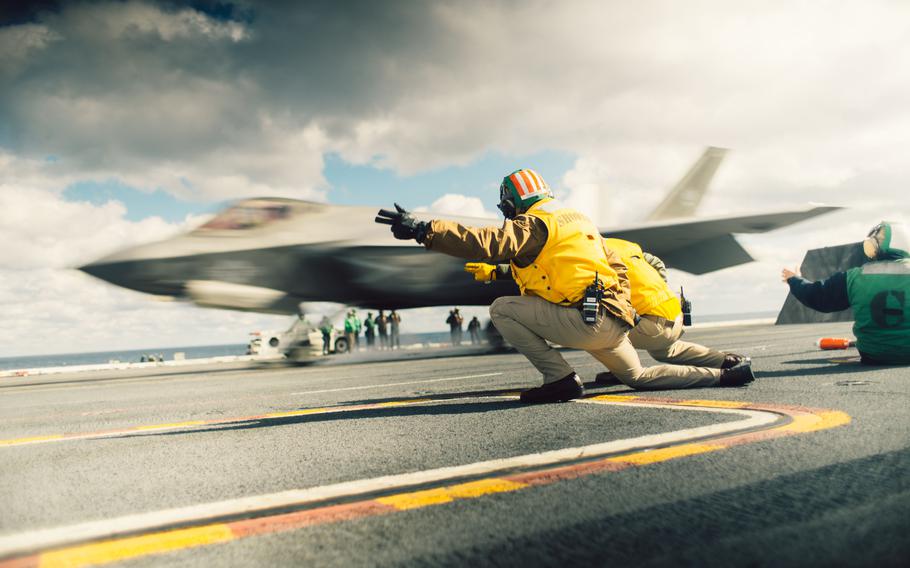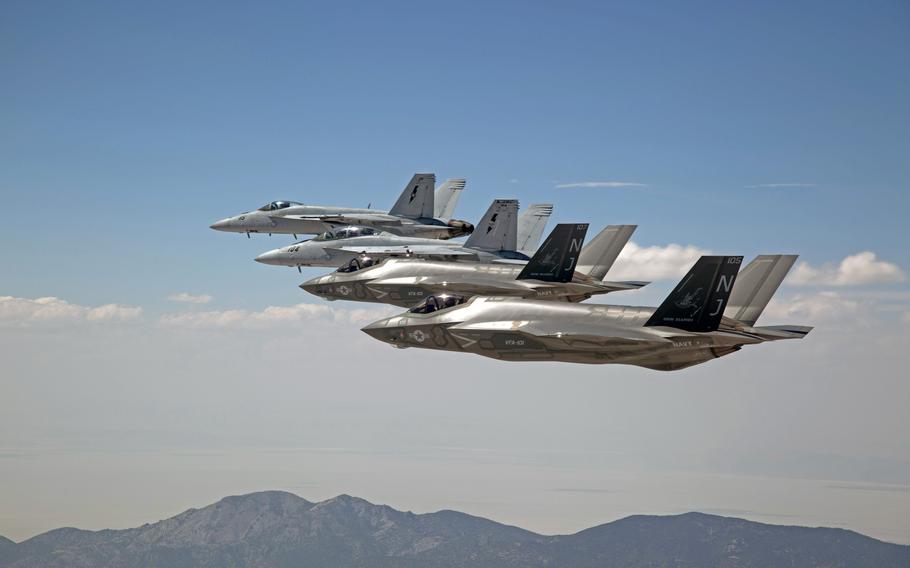
Sailors launch an F-35C Lightning II from Strike Fighter Squadron 125 on Nimitz-class carrier USS George Washington on Jan. 17, 2024. The first F-35C of Marine Fighter Attack Squadron 251, based in Cherry Point, N.C., arrived Sept. 17, and the squadron will be reactivated after more are delivered. (August Clawson/U.S. Navy)
A Marine Corps aviation unit’s return to action is waiting in the wings, pending delivery of enough additional F-35C Lighting II jets to allow it to get going.
The first of Marine Fighter Attack Squadron 251’s planes arrived on Sept. 17 in Cherry Point, N.C., the new home of the squadron nicknamed the Thunderbolts. It was formerly based at Marine Corps Air Station Beaufort in South Carolina.
A fully staffed Marine Corps F-35 squadron consists of 10 aircraft, according to the service. Marine Corps officials did not provide a timeline for the arrival of the remaining jets.
The Thunderbolts could still restart without their full inventory of F-35s, 2nd Marine Aircraft Wing spokesman 2nd Lt. John Graham said Wednesday.
“The squadron’s official reactivation is dependent on the arrival of more aircraft,” he said. “However, achieving full operational capability is not a prerequisite.”
The fifth-generation fighter jet is the first model of its kind to reach the Corps’ East Coast air wing. The squadron is set to support the Navy’s Carrier Air Wing 8.
For 34 years, the unit was an F/A-18 Hornet squadron, but the Marine Corps is replacing its aging fleet of Hornets with the state-of-the-art F-35C.

F-35C Lightning IIs and F/A-18E/F Super Hornets fly over Naval Air Station Fallon in Nevada. Marine Fighter Attack Squadron 251 is preparing to reactivate as an F-35 squadron based in Cherry Point, N.C. (Darin Russell/U.S. Navy)
The squadron was deactivated in 2020 after returning from a deployment in support of Operation Inherent Resolve, the U.S.-led fight against the Islamic State in Iraq and Syria.
In addition, the service’s transition to the F-35 will eventually spell the end for the AV-8B Harrier jets in its fleet. They will give way to the F-35B, a short-takeoff-and-vertical-landing aircraft.
According to the service’s 2022 aviation plan, the Harrier will remain in operations until 2027 but is slowly being phased out.
Marine Fighter Attack Squadron 542, which is the Thunderbolts’ sister squadron at Marine Corps Air Station Cherry Point, will fly the B variant of the F-35. Their activation in April marked the completion of their transition from the Harrier, Graham said.
The F-35 is more stealthy, maneuverable and has better sensor network and fuel capacity, according to the service.
“The one-two punch provided by the F-35C’s increased range and the F-35B’s (short takeoff and vertical-landing) capability will give ... a significant advantage in the future fight,” Col. Benjamin Grant, commander of Marine Aircraft Group 14, the squadrons’ parent command, said in the Sept. 17 statement.